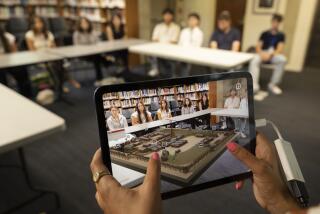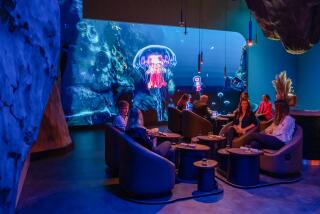3-D Firm Wants to Give Museums, Medicine Added Dimension
A number of museum officials, from the Getty Museum in Malibu to the Smithsonian Institution in Washington, D.C., have a newfound perspective on Eli Whitneyâs 200-year-old cotton gin.
Itâs a 3-D perspective, provided by the folks at Synthonics Technologies, a wholly owned subsidiary of Synthonics Inc. of Westlake Village.
Synthonics officials have created a traveling show to promote the benefits of a patented technology they call Rapid Virtual Reality, through which the user can create a three-dimensional replica of an object or environment on a video screen.
Whitneyâs cotton gin and the Wright brothersâ airplane have been among the main attractions.
Synthonics Technologies officials plan to form partnerships with businesses and individuals representing a variety of industries and license the 3-D RVR technology to customers in those fields. Areas of particular interest are museum archives and educational programs, medical and dental applications and electronic commerce, which would feature the presentation of products on computer screens in 3-D.
Long-term plans include marketing 3-D technology as a way to re-create crime scenes for legal purposes, customize video games and produce special effects for the television and movie industries.
âOur specialty is the technology,â said Michael Budd, president and chief executive of Synthonics Technologies. âSo it made sense to focus on individual industry segments, to find partners that are well known in those segments and go for bigger industrial applications of the technology.â
Synthonics Inc. was founded in 1993 by current President and Chief Executive Charles Palm, who had anticipated manufacturing 3-D hardware and software to be sold on the retail market, particularly to home computer users and engineers.
âBut it became apparent to us that while people want 3-dimensional, they donât want to spend a lot of time or effort on them,â Budd said.
In its pursuit of separate partnerships, Synthonics Technologies thus far has formed 3D DiagnosTx LLC, a limited liability company that is shared with a radiologist and orthodontist. In the health field, the 3-D models are aimed at providing practitioners with accurate images of bone structure and bodily tissue.
Rapid Virtual Reality, Budd said, can be used to aid orthodontic diagnosis and treatment planning, dental implant placement and cosmetic surgery planning.
In addition to the health field, Synthonics Technologies is pushing RVR as a way to maintain archival documentation of museum artifacts and to create educational data and pictures to be used by museum visitors, through CD-ROMs and the Internet.
âA very severe problem for museums is that most of their artifacts are in storage rather than on display,â Budd said. âWeâll create the models for them and package them on a CD with text and audio. Not only will more people have access to the artifacts, but they can also interact with them through animation.â
Budd said that through 3-D animation, items such as the cotton gin or the airplane can be viewed from all sides, opened up and studied as the actual item would be.
âThey received quite a positive reception,â said Charles Carrigan, director of the Smithsonianâs traveling exhibit. âMuseums are institutions that, in addition to the research and preservation of collections, are interested in education. What is really interesting and exciting about this particular software is that it is a real educational tool.â
Carrigan was one of those in attendance for a 3-D cotton gin demonstration.
âItâs one thing to have a docent standing there and another to have the still object in view,â he said. âIf you are able to show it in its entirety, animate it, show how it operates and peel layers off it and add layers to it, youâre crossing over an invisible barrier.â
The Smithsonian currently has a number of interactive programs--interviews with historical figures, prerecorded taped programs or images of certain items. But Carrigan said those programs donât have the impact of the Synthonics technology.
âThis has more of a dramatic element to it,â he said.
Synthonics Technologies officials plan to pursue the museum, medical and electronic commerce industries simultaneously, rather than initially focus on one segment.
âWe are attempting to entrench ourselves into all three marketplaces,â Budd said. âWeâre focusing on three today because all three were in need of 3-dimensional solutions.â
Mark Hardie, a senior analyst at Forrester Research, a market research group in Cambridge, Mass., got a preview of the Synthonics technology and liked what he saw. But he questioned the business strategy.
âSynthonics has a lot of good stuff, but in trying to find all these opportunities, they are stretching themselves a little bit--a lot of folks do that in the beginning,â Hardie said. âIf I were Synthonics, Iâd take a look at the industries that I think there is an opportunity in, and pick one that will be a source of continuing revenue.â
Hardie said that just because a technology works doesnât mean it will sell.
âThere are a number of vendors out there creating 3-D products to solve problems that are specific to each industry, and it tends to be kind of crowded,â he said. âSynthonics has some good stuff and a good management team working for them, but itâs not that cut and dried. It isnât great technology that sells itself, itâs astute marketing.â
More to Read
The biggest entertainment stories
Get our big stories about Hollywood, film, television, music, arts, culture and more right in your inbox as soon as they publish.
You may occasionally receive promotional content from the Los Angeles Times.










